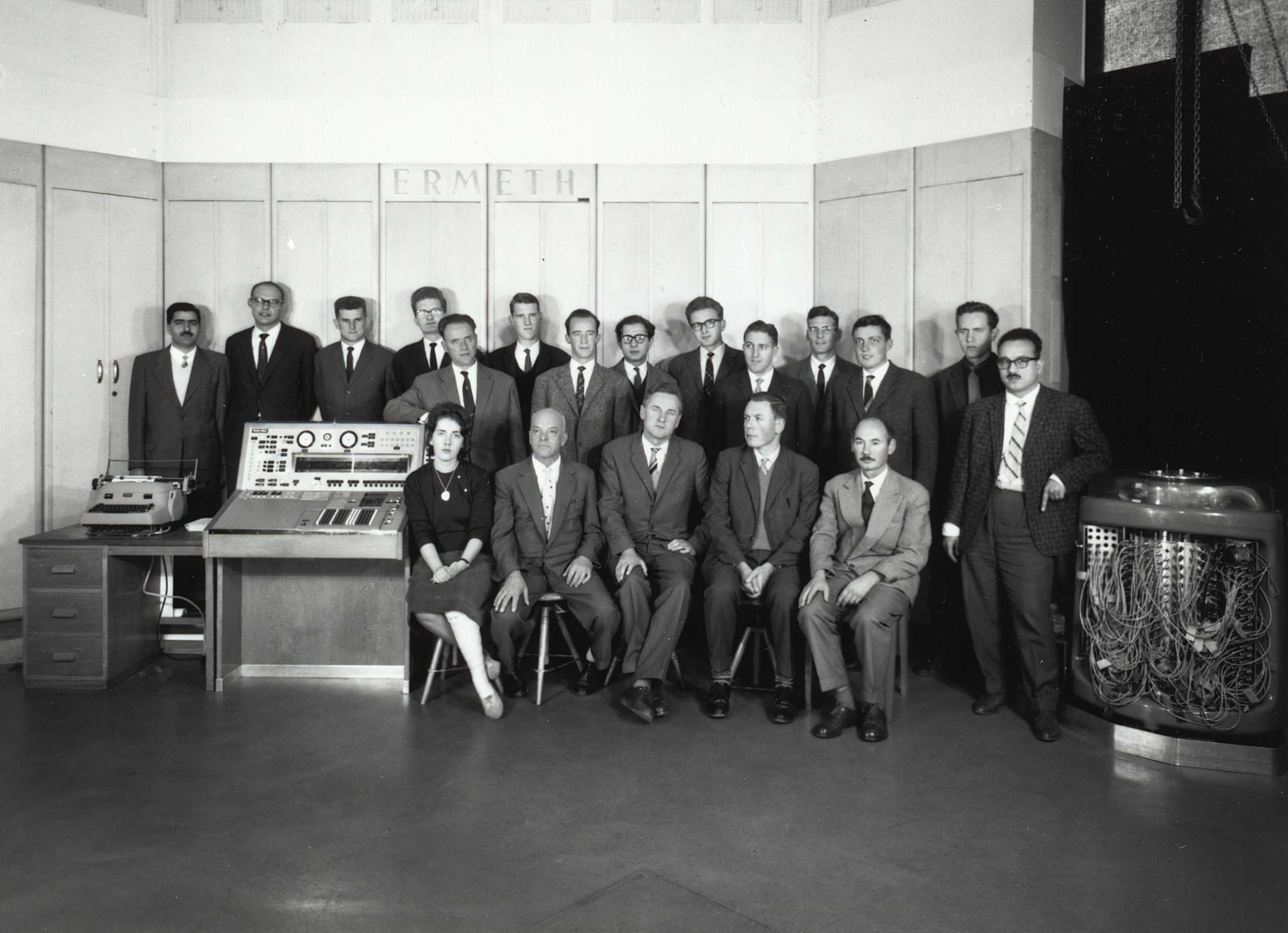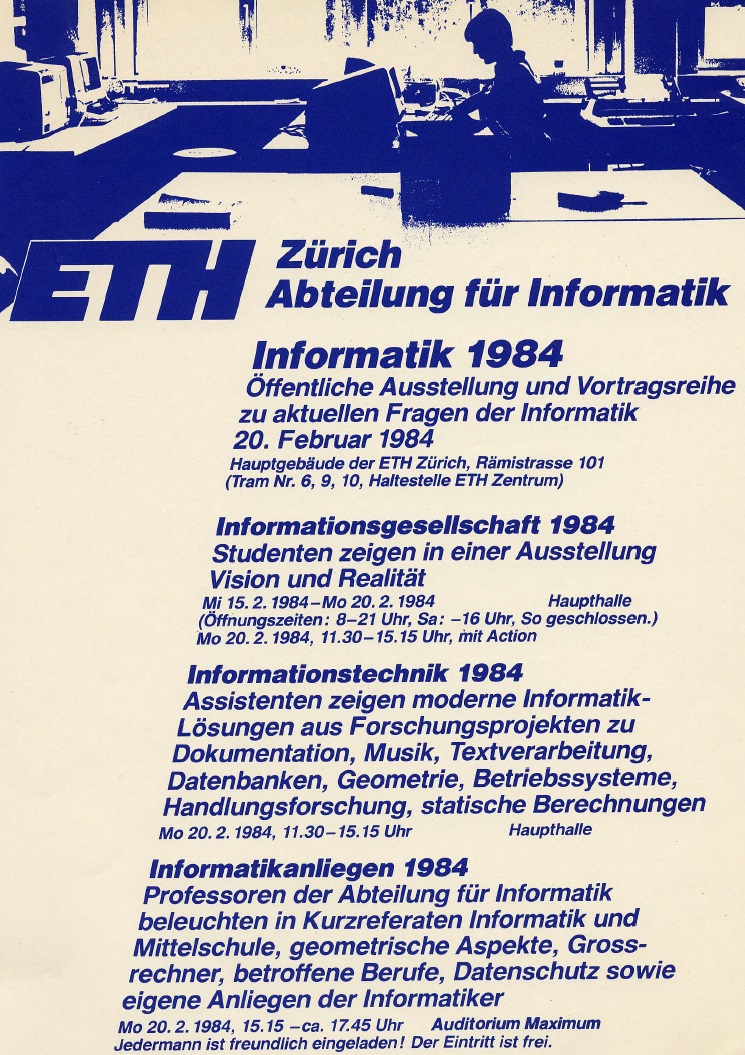Development of the department
In the Autumn Semester of 1981, the first computer science students began their studies at ETH Zurich. The events and developments that would lead to this moment were set in motion more than three decades earlier.
The history of computer science at ETH Zurich began in 1948, when the mathematics professor Eduard Stiefel founded the Institute for Applied Mathematics. The goal of the new institute was to make programmable computing power available at ETH at a time when barely more than a dozen computers were in operation worldwide.
Since building a computer from scratch would take several years, Stiefel began by renting Zuse Z4, a relay computer, in 1950 for five years. At the same time, Stiefel and his assistants, Ambros Speiser and Heinz Rutishauser, began developing the Electronic Calculating Machine of ETH, or ERMETH for short. The researchers had gained the necessary knowledge while on earlier study trips to England and the United States.
ERMETH commenced operations in 1956. By that time, Ambros Speiser had already left ETH and went on to establish the IBM research centre in Rüschlikon, which is still active today. Heinz Rutishauser continued to work with ERMETH at the Institute for Applied Mathematics. As a member of the German Society of Applied Mathematics and Mechanics (GAMM), he contributed to the development of the programming language Algol (Algorithmic Language). Rutishauser and other researchers from GAMM and the American Association for Computing Machinery (ACM) published the first report on Algol-58 at a joint conference held at ETH Zurich in 1958. Following that, Rutishauser's co-worker Hans Rudolf Schwarz wrote an Algol compiler for ERMETH, and Rutishauser wrote an Algol-60 handbook and created the ALCOR programme collection service to facilitate program exchange between universities.

In 1963, ERMETH was decommissioned. The computing industry had developed so rapidly that building a bespoke mainframe no longer made sense. Instead, ETH Zurich purchased a CDC 1604 mainframe as a successor to ERMETH and founded a new computing centre. The new machine was 400 times faster than ERMETH, but it was also more complex to operate and maintain. At the same time, the Institute for Applied Mathematics’ research priorities shifted away from hardware and moved towards algorithms, programming and applications. Thus the institute relinquished responsibility for the new computer, which was now managed directly by the university authorities following the establishment of the computing centre.
In 1968, the Institute for Applied Mathematics split up. Eduard Stiefel and his assistants continued working on problems in the area of celestial mechanics, while Heinz Rutishauser founded the Group for Computer Science, which also included Peter Läuchli and Niklaus Wirth. Shortly after, they were joined by Carl August Zehnder. After Rutishauser passed away in 1970, the group was renamed the Institute for Computer Science.
Go-ahead for computer science curriculum
It was another ten years before computer science received its own study programme, owing to the fact that both the other divisions of ETH and industry as a whole had yet to be convinced that computer science was, indeed, a science. Eventually, in 1981, the Division of Computer Science (Division IIIC) was founded and the “Computer Science Engineer” graduate course was launched thanks to the tireless efforts of Zehnder and Wirth.
In the years before the study programme was introduced, the Institute for Computer Science continued to focus on research. During this time, Niklaus Wirth’s group developed the programming language Pascal and the workstation Lilith. Wirth’s doctoral student Hans-Peter Frei, who would later join the Institute for Computer Science as a professor, developed the teaching system Thales, and Jürg Nievergelt also carried out research into computer-assisted learning.
The establishment of the division and the introduction of a dedicated study programme laid the foundation for today’s Department of Computer Science. In order to be able to meet industry’s intense demand for computer specialists, existing ETH students were allowed to transfer straight into the fifth semester of the new course, provided they had passed their second-year exams. As a result, around 110 first-semester and 23 fifth-semester students began studying computer science at ETH in the autumn of 1981.
Interest in the new study programme proved to be greater than expected, and the existing faculty suddenly had to dedicate a lot more time to teaching before new professorships and assistant positions were filled in order to remedy the situation. Despite this demand on workload due to the founding of the Division IIIC, research activities continued apace. For example, Niklaus Wirth’s and Jürg Gutknecht’s research groups developed the operating system and programming language Oberon, while Hans-Peter Frei’s group worked on a search engine for networks.
In 1988, the Institute for Computer Science evolved into the Department of Computer Science (D-INFK), which consisted of four separate institutes. Until 1996, the Division IIIC continued to exist alongside the department and remained responsible for the teaching of computer science. After 1996, this “matrix structure” was abolished and the responsibility for teaching was transferred to the Director of Studies at the department, which has remained the case to this day.
The researchers in computer science at ETH Zurich have always sought to use their skills and knowledge to advance the institution as a whole. Examples of this include digitising the school’s administrative processes or teaching computer science to students of other departments, an area that is still being expanded today. The rapid development of computer science has also influenced the structure of D-INFK itself: it presently comprises eight institutes and 43 faculty members working on internationally acclaimed cutting-edge research.
The Department of Computer Science today
Historical documents
- Download Press release of ETH Zurich about the introduction of the new graduate course in computer science, 1981; in German (PDF, 121 KB)
- Download Orientation for middle schools concerning the new computer science graduate course, 1981; in German (PDF, 941 KB)
- Download Computer Science at ETH Zurich 1948–1981: Science, Service and Administration Element (Andreas Nef and Tobias Wildi, 2006); in German (PDF, 747 KB)


